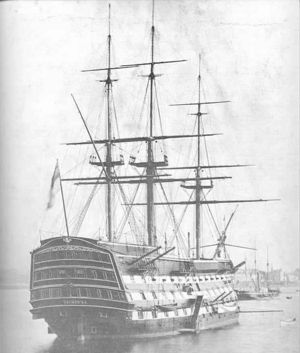Difference between revisions of "Ship of the line"
Whitearrow (talk | contribs) m |
Whitearrow (talk | contribs) m |
||
| (2 intermediate revisions by the same user not shown) | |||
| Line 3: | Line 3: | ||
A ship of the line, therefore, was any ship large enough to take its place in the line of battle. Generally, this meant first, second, or third-rate ships, which had guns on two or more decks. | A ship of the line, therefore, was any ship large enough to take its place in the line of battle. Generally, this meant first, second, or third-rate ships, which had guns on two or more decks. | ||
| − | First-rates were the largest ships of the line, carrrying 100 or more guns on three gundecks and over 800 men. The most famous first-rate was the HMS Victory, Lord [[Horatio Nelson]]'s flagship at the [[Battle of Trafalgar]]. | + | First-rates were the largest ships of the line, carrrying 100 or more guns on three gundecks and over 800 men. The most famous first-rate was the [[HMS Victory]], Lord [[Horatio Nelson]]'s flagship at the [[Battle of Trafalgar]]. |
| + | |||
| + | |||
| + | [[Image:Victory.jpg|center|300 px]] | ||
| + | |||
| + | |||
| + | <center>''The HMS Victory, the only surviving first-rate from the Age of Sail.''</center> | ||
| + | |||
Second-rates carried 90 to 98 guns, typically on three gun decks, and a crew of 750. | Second-rates carried 90 to 98 guns, typically on three gun decks, and a crew of 750. | ||
| Line 9: | Line 16: | ||
Third-rates carried 64 to 80 guns, typically on two gun decks, and crews of 500 to 700. 74-gun ships were popular among the navies of several nations, and the term "third rate" might apply to a captured French 74, for example. | Third-rates carried 64 to 80 guns, typically on two gun decks, and crews of 500 to 700. 74-gun ships were popular among the navies of several nations, and the term "third rate" might apply to a captured French 74, for example. | ||
| − | Ships too small to stand in the line were used for other purposes such as patrolling, scouting, escorting convoys, etc. The frigate, which had all its guns on one deck, was considered the most successful design for such uses. | + | Ships too small to stand in the line were used for other purposes such as patrolling, scouting, escorting convoys, etc. The frigate, which had all its guns on one deck, was considered the most successful design for such uses. The French ship [[Amitie]], captured by [[William Laurence]] and the [[HMS Reliant]] in 1805, was a 36-gun frigate. |
{{expand}} | {{expand}} | ||
| Line 15: | Line 22: | ||
[[Category:A-Z]] | [[Category:A-Z]] | ||
[[Category:British Military]] | [[Category:British Military]] | ||
| + | [[Category:Royal Navy]] | ||
Latest revision as of 18:45, 29 September 2006
During the mid-17th century, the Royal Navy developed the "line of battle" tactic, in which ships would form a line and face the enemy rather than approaching for one-on-one combat. Because the ships would stand and fight, they had to be of a certain size and weight to stand in the line.
A ship of the line, therefore, was any ship large enough to take its place in the line of battle. Generally, this meant first, second, or third-rate ships, which had guns on two or more decks.
First-rates were the largest ships of the line, carrrying 100 or more guns on three gundecks and over 800 men. The most famous first-rate was the HMS Victory, Lord Horatio Nelson's flagship at the Battle of Trafalgar.
Second-rates carried 90 to 98 guns, typically on three gun decks, and a crew of 750.
Third-rates carried 64 to 80 guns, typically on two gun decks, and crews of 500 to 700. 74-gun ships were popular among the navies of several nations, and the term "third rate" might apply to a captured French 74, for example.
Ships too small to stand in the line were used for other purposes such as patrolling, scouting, escorting convoys, etc. The frigate, which had all its guns on one deck, was considered the most successful design for such uses. The French ship Amitie, captured by William Laurence and the HMS Reliant in 1805, was a 36-gun frigate.
